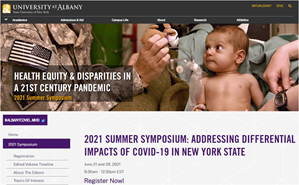Summer 2021 and Differential Impacts of “COVID Slide”
by Aaron Leo, Jessie Tobin, and Kristen C. Wilcox
As the school year comes to a close and summer approaches, educators and researchers have already begun thinking about how to best prepare for school this fall. This blog explores research about potential impacts due to the extended period of time away from in-person learning and provides some insights into what might be done to regain momentum and address differential impacts on children and youth.
“Summer and COVID slide”: Not the Same in All Subjects and for All Children
Prior research has suggested that the summer months can involve a slowing or loss of learning and this experience can differ significantly from one subject and one student to the next. While some have challenged the veracity of the “summer slide” or “summer melt” claim, others see it as a significant factor in the persistence of performance disparities by class and race.
 These concerns have prompted researchers to consider how the COVID-19 pandemic might have affected the 50 million children who spent most of the 2020-2021 school year not in classrooms, but in their homes.
These concerns have prompted researchers to consider how the COVID-19 pandemic might have affected the 50 million children who spent most of the 2020-2021 school year not in classrooms, but in their homes.
Recent research suggests that school shutdowns and shifts to remote learning may mean a greater “slide” in the summer of 2021 and widening disparities for the most vulnerable youth. The NWEA, for example, projects that students may only retain 70% of reading gains and less than 50% in math gains made over the last year. And in another report, researchers have projected that a combination of factors like trauma and job loss are likely to affect youth of color and those growing up in poverty differently, but much more data are needed to draw conclusions.
Still other studies have found that “COVID slide” may not be as steep as predicted – however data sets are largely incomplete to draw conclusions.
Finally, some have found that learning gaps or losses – however drastic – are likely to be most pronounced for students in earlier grades and for children with disabilities.
Preparing to Use Summer Strategically
District and school leaders, aware of these pressing issues, are already hiring additional staff to assist with the large number of summer classes needed and some schools are also partnering with local libraries to help offset the impact of COVID slide by offering new or expanded summer reading programs.
These summer learning opportunities may not be enough to combat COVID slide, however. So some school and district leaders are considering bringing students back earlier in the fall or extending the school year. Longer school days or additional after school programs have also been considered as a way to help give students extra time to reconnect with their teachers and peers.
 Parents and families are also being called upon to help ameliorate the effects of COVID slide by encouraging their children to read over the summer, downloading educational apps, or having their children work with a tutor or another adult volunteer. However, such steps may be challenging for many families who are struggling with the social and economic fallout from the pandemic.
Parents and families are also being called upon to help ameliorate the effects of COVID slide by encouraging their children to read over the summer, downloading educational apps, or having their children work with a tutor or another adult volunteer. However, such steps may be challenging for many families who are struggling with the social and economic fallout from the pandemic.
For more information on NYKids’ current research on the effects of the pandemic on the educator workforce please check out the 2021 Summer Symposium: Addressing Differential Impacts of Covid-19 In New York State on June 21 and 28, 2021.
Also visit our other blogs on this topic and reach out to us with any comments or questions about our research or to request direct support for planning for reopening in the fall at: nykids@albany.edu
